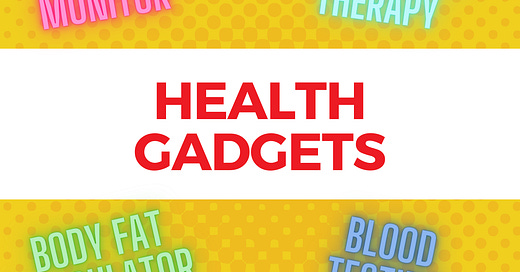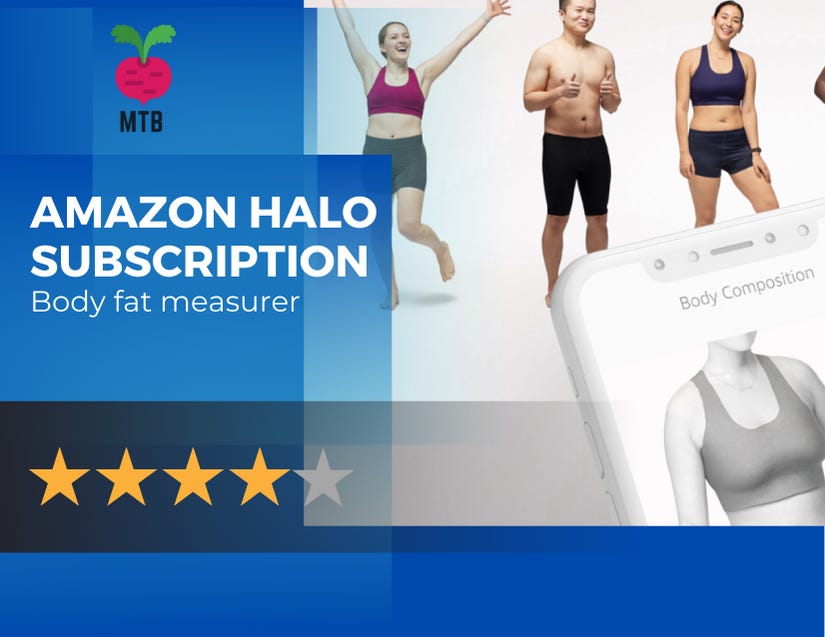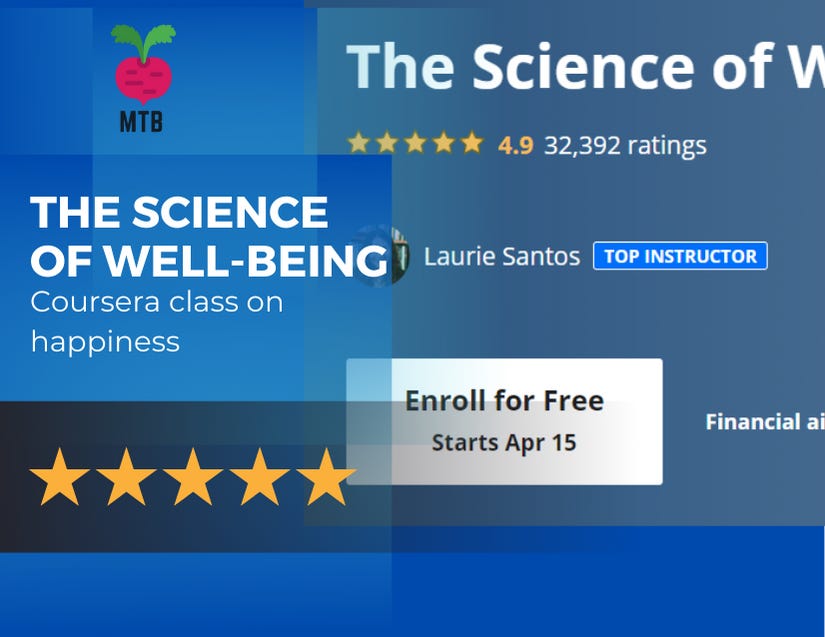A sabbatical goal I had was to take a more holistic approach to health. I’m turning 40 this year - which doesn’t make me old per se, but it does mean the stage where I can do whatever I want with my body and mind is over. A place in life where the world reminds you to think about preventative maintenance, while there is still plenty of time.
Here are a few things I checked out of the past few months that I thought folks might find helpful in their own lives.
💆♂️Theragun
Problem it solves: Reduces knee pain
Helen got this for me as she saw it used frequently in her physical therapy office. I was a bit skeptical (perhaps Sharper Image biased me against home massage machines) and also wasn’t sure I could effectively use it on myself and by myself.
But this product has opened up more exercise doors for me than any other. As I picked up long-distance running, I incorporated Theragun on my IT band in the cool-down period. As someone who has constantly dealt with knee pain as my distance increased, this solved it completely.
I am impressed with the attention to detail and workmanship of the device. Sturdy to hold, well-balanced weight distribution, high-quality parts. It feels like Apple made a massage gun.
Ditch the foam roller. Use Theragun. It’s seriously amazing. I use this nearly daily now.
🦠CUE Health Reader
Problem it solves: PCR-level COVID results in 30 minutes, at home
No device has made me feel like I’m living in the future more than our CUE reader. The device is about the size of two decks of cards and each test is the size of a lighter. It connects via Bluetooth to a slick mobile app where everything from test administration, to billing, to test ordering - it is all handled seamlessly.
Right now, we use it for at-home COVID test results that are as accurate and accepted as PCR testing. Results in 30 minutes. This has provided so much peace of mind for our family in the 4 months we’ve had the device. With two different schools, each with different policies, being able to produce results that the schools will accept in the morning before it starts has been critical to keeping our house moving. It’s more important now than ever with maskless classrooms and a return of camps and after-school activities. It’s portable and you can take it with you to travel.
We’ve had an almost 20% failure rate with the tests (where it says results are invalid and must be redone), which is not ideal (as you need to budget an hour, not 30 mins, in case a test fails) - but they send a free replacement when that happens (they use Amazon for warehousing so it arrives super quick).
In the future, they promise more types of tests than just COVID. This is the same system used by the MLB and the NBA. Their subscription model makes you feel like you are paying for more than you need (only the higher-end subscription offers the certified results, and the tests that come with the subscription are staggered in 6-month intervals so you order more in the interim). So their business model + the high invalid test rate prevent a 5-star rating, but this is still an incredibly valuable peace-of-mind purchase for our family.
🍵Athletic Greens
Problem it solves: Vitamins on an empty stomach
We discovered this from Michael Gervais’ Finding Mastery Podcast. It’s a supplement that you stir into water. It has a lot of what you’d get out of a multi-vitamin plus some great stuff for gut health and immunity. I like that it has lots of Vitamin C and Zinc. The biggest plus for me is that I can tolerate this first thing in the morning on an empty stomach (something I can’t do with a standard multi-vitamin).
It was hard to identify something specific that improved after adding it to my routine, so I hesitate to give it 5 stars - yet I still feel great that it covers my basics for potentially missing nutrients and then has a few other things that could be very helpful beyond the multi-vitamin. Link here for more info about Athletic Greens.
🎮Signos
Problem it solves: Gamify your nutrition
Signos is one of many companies that are bringing Continuous Glucose Monitoring to the masses. You get a Dexcom G6 CSM receiver and 3 months supply of monitors. You have to install two mobile apps to get it all to work (one of which is still using Apple’s TestFlight beta program). And you get access to a Facebook group of other users to provide feedback and share best practices.
A CSM will, as you’d expect, constantly monitor your glucose. Signos gives you pretty graphs on your phone and it integrates with Apple Watch so it’ll overlay exercises on top of the graph. You have to submit your own food journal so the exercise/diet full overlay over glucose takes shape.
The pitch is that you should keep your glucose in a narrow range. The Signos app is designed heavily around weight loss vs. any other health outcomes, so the theory is if you take a walk when your glucose spikes after a carb-heavy meal, you can be in a weight-loss window. Or avoid the foods you know spike your glucose.
I personally used it for insights into how my body responded to different foods and exercises - I still have a month left so my next round might be more into the gamification aspect of it to see the impact on my body.
I really like the instant feedback it provides on my diet and exercise actions. The community of similarly-minded users was a great source of inspiration. The monitor itself was relatively innocuous (I chose my left upper arm) and the apps were pretty slick. Signos chose to give you a series of challenges (log you food, calibrate the sensor) and they are undissmissable and you can’t proceed to the next challenge until you complete the current one, which I found too brittle for my lifestyles.
There is real promise to monitors that provide more instant feedback and help people understand their health and the impact of their choices. I left thinking this was part of a larger solution over time - have CGM in a walled garden separate from my blood tests, doctor’s recommendations, and other factors of nutrition seem like a point-in-time limitation in the market here.
📈Inside Tracker
Problem it solves: Science-back food recs from blood analysis
My GP is part of a major health collective, so I feel like I got nothing but a Thumbs Up from the yearly blood draw and analysis. The system was designed to catch those in serious trouble, not help healthy people tune themselves.
So I was excited about Inside Tracker. Not only does it expand the markers that it analyzes (e.g. testosterone level) but it also gives you a mobile app that helps you geek out on each marker, what normal levels are, how strong the science is behind it, and recommendations if a marker is off. This satisfied my curiosity quotient as well as the “Can I find something new to optimize?” questions I had.
My experience has been pretty mixed. My results were, frankly, boring - slightly high cholesterol but nothing my doctor was worried about and low Vitamin D (like everyone in Seattle). All the other markers, including the fancy things that get beyond the doctor’s standard, were normal. Maybe doctors actually know something! So the recommendations - eat less red meat & processed meat, more fish and shellfish, take a Vitamin D supplement - were likewise pretty quotidian.
When you combine those results with the high price of the service and the annoying marketing tactics (you can easily find discount codes off the rack rate - but this is my health not a flight to Mexico! And the app seems more interested in upselling me to other packages than it does to be helpful), I will call this experiment a bust.
📸Amazon Halo Health Subscription
Problem it solves: Super accurate body fat percentage
I got a Halo band as a fitness tracker a while ago and abandoned it in favor of the Apple Watch. But the service attached to Halo hooked me and I continue to pay a small monthly fee for the ability to get super accurate body fat percentages. It uses your phone’s camera to take a full-body scan (which you might find creepy - I’m OK with it given its utility). I try to do this every 2-4 weeks so I can track body fat percentage - which is way more important than weight.
🥰Dr. Santos’ Coursera Class on the Psychology of Happiness
Problem it solves: Best framing for mental wellness
Drop what you are doing and start this class right now. It’s like a warm hug to your mental wellness. Dr. Santos explains to you what you already feel but couldn’t articulate - what science says is key to sustained happiness. She gives an overview of the field of Positive Psychology - how science can help relatively healthy and well-adjusted folks vs. focusing on pathologies - and its chock-full of wonderful little nuggets of wisdom.
One of the things that brought me the most joy was hearing my kids ask “What did you learn about happiness today?” at the dinner table and I could share some study or insight that was approachable to them.
The course is free on Coursera and well worth the time.
Wrapping Up
My Health + Cool Tech Toys + Analysis of Business Models & Trends = A fun experiment. Let me know if you check out any of these, or if you have others to try!










